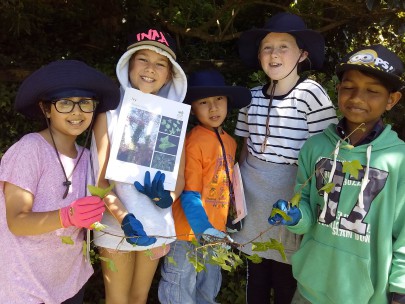Wakaaranga Primary School, Auckland
In this section
-
Participating schools
- Curious Minds visit Lincoln
- Franz Josef & Fox Glacier Schools
- Greymouth High School
- Haast School
- Halswell Domain
- Halswell School
- Heathcote Valley School
- Kaniere School
- Kaniere visit Lincoln
- Hokitika Primary
- Leeston Consolidated School
- Manuka Primary School
- Mission Heights
- Mt Albert Grammar
- Paroa School
- Rudolf Steiner School
- Takapuna Grammar
- TKKM
- Wakaaranga Primary School
- Whataroa School

Students collecting ivy. Photographed by a student of Wakaaranga Primary School
Our visit coincided with the Tread Lightly Caravan being onsite. It was great to have a strong environmental and sustainability presence in the school at the same time and to see what the main focus of our Auckland educators are for their separate in-school visits.
Our “weedy” activities were spread over two days, which worked well due to the large class size (44 students) and mixed ages (Y2–5). Despite the full-on challenges of delivering to this large and mixed class, everything went well. Teaching progressed smoothly and the students were really interested and engaged in all activities. The younger and older students worked well together.
Jackie Scoggins and Kylee Hanlon-Judd were the teachers who hosted us – both are enviro-leaders.
The first day followed a schedule of Monique leading the classroom-based activities explaining what weeds are, perceptions and values of plants, and teaching about ecological relationships of plants and animals. Murray brought along a wide range of weeds that he collected locally for the class to study and identify. Hugh brought his green thistle beetles (Cassida rubiginosa) and tradescantia leaf beetles (Neolema ogloblini) for the students to handle and learn more about biocontrol.
Our field trip on the second day was a loop walk on the Rotary Walkway near Wakaaranga Creek Reserve (just north of the school). This was an ideal location to find a wide range of weeds, native plants and cultivated material. Four parents/caregivers and two teachers joined us.
What were some of the plants that we found?
We found a wide range of weeds that were likely planted in adjacent residential gardens, before becoming weedy along the walkway. The usual culprits that ‘jump the garden fence’ included:
- agapanthus (Agapanthus praecox ssp. orientalis)
- common ivy (Hedera helix)
- cotoneaster
- jasmine (Jasminum polyanthum)
- tuber ladder fern (Nephrolepis cordifolia).
There was a large patch of bear’s breeches (Acanthus mollis) found in undergrowth on a bank below the walkway. Bear’s breeches is another common garden escape, and again, planted examples were found nearby.
Moth plant (Araujia hortorum) was found climbing up trees and shrubs along the walkway. Moth plant is a major Environmental Weed in Auckland that can spread far and wide due to the wind-dispersed seeds that are produced in abundance.
Another nasty Environmental Weed found along the walkway was woolly nightshade (Solanum mauritianum). Some other common Environmental Weeds that we found included:
- arum lily – green form (Zantedeschia aethiopica ‘Green Goddess’)
- arum lily – white form (Zantedeschia aethiopica)
- large bindweed (Calystegia silvatica)
- nasturtium (Tropaeolum majus)
- pampas grass (Cortaderia selloana).
We found other weeds that are less commonly encountered in the urban areas we have visited in the past:
- Bangalow palm (Archontophoenix cunninghamiana) – we found a spot where there were lots of seedlings
- lantana (Lantana camara) – possibly originally cultivated at this location
- Queensland poplar (Homalanthus populifolius)
- tutsan (Hypericum androsaemum).
The Natal lily (Clivia miniata), is classed as a casual naturalisation (in other words, occasionally weedy). The specimen we recorded was growing in what looks like the foot of a neglected/former garden, so it may have originally been planted there. However, others were seen in the area that are more convincingly naturalised.
Towards the end of the day, the class gathered on a lawn next to a good patch of tradescantia. There, Hugh talked about tradescantia and the beetles used for biological control, before teacher Jackie Scoggins released tradescantia leaf beetles (Neolema ogloblini) onto the site.
Nearby we found a tree that had been toppled under the sheer weight of an invasive climber. The iNaturalist community helped us identify this weedy climber as Madeira vine (Anredera cordifolia).
It was a busy day and in total we recorded 150 observations of more than 60 species. This excellent effort has placed Wakaaranga Primary School near the top of the iNaturalist NZ schools leader-board.














![Close-up of tradescantia beetles ([Neolema ogloblini], aka ‘Shiny’). Photographed by a student of Wakaaranga Primary School Image](/assets/Education/Schools-Great-weeds-hunt/029_Wakaaranga_School__FillMaxWzE1LDE1XQ.jpeg)
